
Wandering albatross in flight, over the open sea. The wandering albatross has the largest wingspan of any living bird, with the wingspan between, up to 12' from wingtip to wingtip. It can soar on the open ocean for hours at a time, riding the updrafts from individual swells, with a glide ratio of 22 units of distance for every unit of drop. The wandering albatross can live up to 23 years. They hunt at night on the open ocean for cephalopods, small fish, and crustaceans. The survival of the species is at risk due to mortality from long-line fishing gear.
Species: Wandering albatross, Diomedea exulans
Location: Southern Ocean
Image ID: 24071
Species: Wandering albatross, Diomedea exulans
Location: Southern Ocean
Image ID: 24071

King penguin, showing ornate and distinctive neck, breast and head plumage and orange beak.
Species: King penguin, Aptenodytes patagonicus
Location: Fortuna Bay, South Georgia Island
Image ID: 24581
Species: King penguin, Aptenodytes patagonicus
Location: Fortuna Bay, South Georgia Island
Image ID: 24581

Mountains, glaciers and ocean, the rugged and beautiful topography of South Georgia Island.
Location: Grytviken, South Georgia Island
Image ID: 24580
Location: Grytviken, South Georgia Island
Image ID: 24580
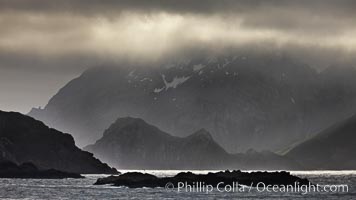
South Georgia Island coastline, showing the island's characteristic rugged topography. 56% of the island is covered by 161 glaciers, which have created numerous large bays and inlets that provide excellent habitat for marine animals and seabirds. Mountains meet the sea in steep-sided seacliffs covered with sparse vegetation. The highest point on South Georgia Island is Mt. Paget at 2,915m.
Location: South Georgia Island
Image ID: 24317
Location: South Georgia Island
Image ID: 24317
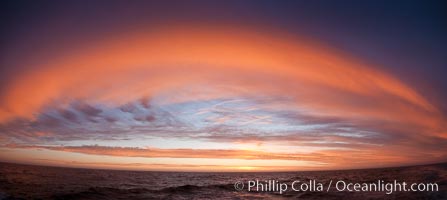
Sunset clouds create a colorful arch, spanning the heavens from horizon to horizon, over the open sea between the Falkland Islands and South Georgia Island.
Location: Southern Ocean
Image ID: 24073
Location: Southern Ocean
Image ID: 24073

Hiker looks down on Stromness Harbour from the pass high above.
Location: Stromness Harbour, South Georgia Island
Image ID: 24582
Location: Stromness Harbour, South Georgia Island
Image ID: 24582

Salisbury Plain on South Georgia Island is home to an immense rookery of King Penguins. It is a spectacular wildlife location, unequaled in all the world.
Location: Salisbury Plain, South Georgia Island
Image ID: 24682
Panorama dimensions: 1886 x 21281
Location: Salisbury Plain, South Georgia Island
Image ID: 24682
Panorama dimensions: 1886 x 21281
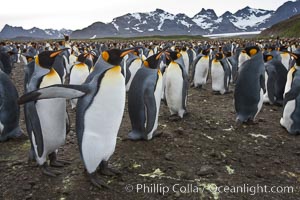
King penguin colony. Over 100,000 pairs of king penguins nest at Salisbury Plain, laying eggs in December and February, then alternating roles between foraging for food and caring for the egg or chick.
Species: King penguin, Aptenodytes patagonicus
Location: Salisbury Plain, South Georgia Island
Image ID: 24388
Species: King penguin, Aptenodytes patagonicus
Location: Salisbury Plain, South Georgia Island
Image ID: 24388

Adult male Antarctic fur seal (bull), chasing down a female in his harem to confirm his dominance, during mating season.
Species: Antarctic fur seal, Arctocephalus gazella
Location: Right Whale Bay, South Georgia Island
Image ID: 24334
Species: Antarctic fur seal, Arctocephalus gazella
Location: Right Whale Bay, South Georgia Island
Image ID: 24334

King penguin colony and the Bay of Isles on the northern coast of South Georgia Island. Over 100,000 nesting pairs of king penguins reside here. Dark patches in the colony are groups of juveniles with fluffy brown plumage. The icebreaker M/V Polar Star lies at anchor.
Species: King penguin, Aptenodytes patagonicus
Location: Salisbury Plain, South Georgia Island
Image ID: 24383
Species: King penguin, Aptenodytes patagonicus
Location: Salisbury Plain, South Georgia Island
Image ID: 24383

King penguins gather in a steam to molt, below a waterfall on a cobblestone beach at Hercules Bay.
Species: King penguin, Aptenodytes patagonicus
Location: Hercules Bay, South Georgia Island
Image ID: 24384
Species: King penguin, Aptenodytes patagonicus
Location: Hercules Bay, South Georgia Island
Image ID: 24384

Fortuna Bay, with icebreaker M/V Polar Star at anchor.
Location: Fortuna Bay, South Georgia Island
Image ID: 24593
Location: Fortuna Bay, South Georgia Island
Image ID: 24593
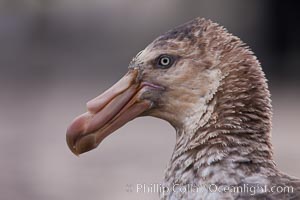
Northern giant portrait, profile, head detail. The distinctive tube nose (naricorn), characteristic of species in the Procellariidae family (tube-snouts), is easily seen.
Species: Northern giant petrel, Macronectes halli
Location: Right Whale Bay, South Georgia Island
Image ID: 23679
Species: Northern giant petrel, Macronectes halli
Location: Right Whale Bay, South Georgia Island
Image ID: 23679

M/V Polar Star, an icebreaker expedition ship, lies at anchor in Right Whale Bay, South Georgia Island. Antarctic fur seals on the beach, and the rugged South Georgia Island mountains in the distance. Sunset, dusk.
Species: Antarctic fur seal, Arctocephalus gazella
Location: Right Whale Bay, South Georgia Island
Image ID: 24318
Species: Antarctic fur seal, Arctocephalus gazella
Location: Right Whale Bay, South Georgia Island
Image ID: 24318

Wandering albatross, on nest and the Prion Island colony. The wandering albatross has the largest wingspan of any living bird, with the wingspan between, up to 12' from wingtip to wingtip. It can soar on the open ocean for hours at a time, riding the updrafts from individual swells, with a glide ratio of 22 units of distance for every unit of drop. The wandering albatross can live up to 23 years. They hunt at night on the open ocean for cephalopods, small fish, and crustaceans. The survival of the species is at risk due to mortality from long-line fishing gear.
Species: Wandering albatross, Diomedea exulans
Location: Prion Island, South Georgia Island
Image ID: 24385
Species: Wandering albatross, Diomedea exulans
Location: Prion Island, South Georgia Island
Image ID: 24385

King penguin preening. Salisbury Plain, Bay of Isles, South Georgia Island.
Species: King penguin, Aptenodytes patagonicus
Location: Salisbury Plain, South Georgia Island
Image ID: 24387
Species: King penguin, Aptenodytes patagonicus
Location: Salisbury Plain, South Georgia Island
Image ID: 24387
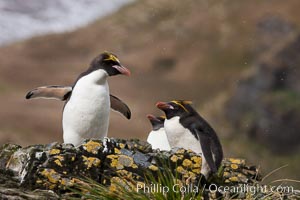
Macaroni penguins, on the rocky shoreline of Hercules Bay, South Georgia Island. One of the crested penguin species, the macaroni penguin bears a distinctive yellow crest on its head. They grow to be about 12 lb and 28" high. Macaroni penguins eat primarily krill and other crustaceans, small fishes and cephalopods.
Species: Macaroni penguin, Eudyptes chrysolophus
Location: Hercules Bay, South Georgia Island
Image ID: 24390
Species: Macaroni penguin, Eudyptes chrysolophus
Location: Hercules Bay, South Georgia Island
Image ID: 24390

Antarctic fur seal.
Species: Antarctic fur seal, Arctocephalus gazella
Location: Hercules Bay, South Georgia Island
Image ID: 24392
Species: Antarctic fur seal, Arctocephalus gazella
Location: Hercules Bay, South Georgia Island
Image ID: 24392

Macaroni penguin, on the rocky shoreline of Hercules Bay, South Georgia Island. One of the crested penguin species, the macaroni penguin bears a distinctive yellow crest on its head. They grow to be about 12 lb and 28" high. Macaroni penguins eat primarily krill and other crustaceans, small fishes and cephalopods.
Species: Macaroni penguin, Eudyptes chrysolophus
Location: Hercules Bay, South Georgia Island
Image ID: 24393
Species: Macaroni penguin, Eudyptes chrysolophus
Location: Hercules Bay, South Georgia Island
Image ID: 24393

Oakum boys, juvenile king penguins at Salisbury Plain, South Georgia Island. Named 'oakum boys' by sailors for the resemblance of their brown fluffy plumage to the color of oakum used to caulk timbers on sailing ships, these year-old penguins will soon shed their fluffy brown plumage and adopt the colors of an adult.
Species: King penguin, Aptenodytes patagonicus
Location: Salisbury Plain, South Georgia Island
Image ID: 24405
Species: King penguin, Aptenodytes patagonicus
Location: Salisbury Plain, South Georgia Island
Image ID: 24405

Oakum boys, juvenile king penguins at Salisbury Plain, South Georgia Island. Named 'oakum boys' by sailors for the resemblance of their brown fluffy plumage to the color of oakum used to caulk timbers on sailing ships, these year-old penguins will soon shed their fluffy brown plumage and adopt the colors of an adult.
Species: King penguin, Aptenodytes patagonicus
Location: Salisbury Plain, South Georgia Island
Image ID: 24406
Species: King penguin, Aptenodytes patagonicus
Location: Salisbury Plain, South Georgia Island
Image ID: 24406

King penguin colony at Salisbury Plain, Bay of Isles, South Georgia Island. Over 100,000 pairs of king penguins nest here, laying eggs in December and February, then alternating roles between foraging for food and caring for the egg or chick.
Species: King penguin, Aptenodytes patagonicus
Location: Salisbury Plain, South Georgia Island
Image ID: 24431
Species: King penguin, Aptenodytes patagonicus
Location: Salisbury Plain, South Georgia Island
Image ID: 24431

King penguin colony. Over 100,000 pairs of king penguins nest at Salisbury Plain, laying eggs in December and February, then alternating roles between foraging for food and caring for the egg or chick.
Species: King penguin, Aptenodytes patagonicus
Location: Salisbury Plain, South Georgia Island
Image ID: 24456
Species: King penguin, Aptenodytes patagonicus
Location: Salisbury Plain, South Georgia Island
Image ID: 24456
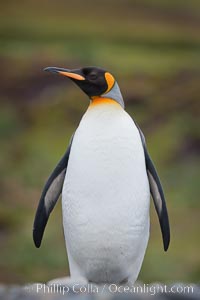
King penguin, solitary, standing.
Species: King penguin, Aptenodytes patagonicus
Location: Fortuna Bay, South Georgia Island
Image ID: 24602
Species: King penguin, Aptenodytes patagonicus
Location: Fortuna Bay, South Georgia Island
Image ID: 24602
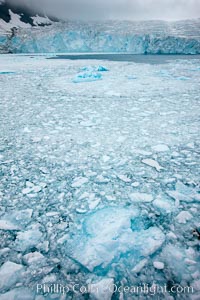
Drygalski Fjord, packed with brash ice which has broken away from Risting Glacier at the end of the narrow fjord.
Location: Drygalski Fjord, South Georgia Island
Image ID: 24687
Location: Drygalski Fjord, South Georgia Island
Image ID: 24687

M/V Polar Star approaches Jenkins Glacier (left), Risting Glacier (center) and a third glacier (right) at the end of Drygalski Fjord.
Location: Drygalski Fjord, South Georgia Island
Image ID: 24688
Location: Drygalski Fjord, South Georgia Island
Image ID: 24688
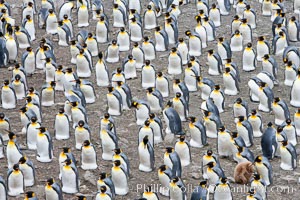
King penguin colony. Over 100,000 pairs of king penguins nest at Salisbury Plain, laying eggs in December and February, then alternating roles between foraging for food and caring for the egg or chick.
Species: King penguin, Aptenodytes patagonicus
Location: Salisbury Plain, South Georgia Island
Image ID: 24386
Species: King penguin, Aptenodytes patagonicus
Location: Salisbury Plain, South Georgia Island
Image ID: 24386

Antarctic fur seal, on grass slopes high above Fortuna Bay.
Species: Antarctic fur seal, Arctocephalus gazella
Location: Fortuna Bay, South Georgia Island
Image ID: 24583
Species: Antarctic fur seal, Arctocephalus gazella
Location: Fortuna Bay, South Georgia Island
Image ID: 24583

Gentoo penguins, calling, heads raised.
Species: Gentoo penguin, Pygoscelis papua
Location: Godthul, South Georgia Island
Image ID: 24690
Species: Gentoo penguin, Pygoscelis papua
Location: Godthul, South Georgia Island
Image ID: 24690
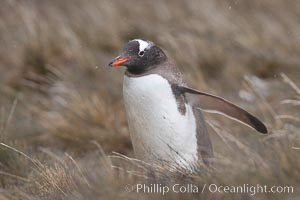
Gentoo penguin walking through tall grass.
Species: Gentoo penguin, Pygoscelis papua
Location: Godthul, South Georgia Island
Image ID: 24701
Species: Gentoo penguin, Pygoscelis papua
Location: Godthul, South Georgia Island
Image ID: 24701